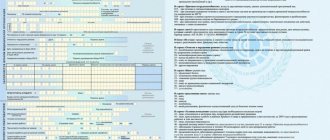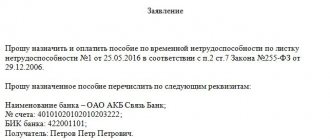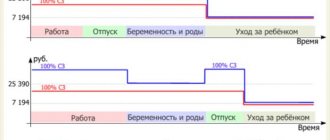If an employee falls ill or is injured, either at home or at work, he contacts a medical organization and receives sick leave. A certificate of incapacity for work is the basis for payment of sick leave benefits for the entire period of the employee’s absence from the enterprise due to deteriorating health. But often accountants have questions about sick leave during downtime. We suggest you find out whether sick leave will be paid to the employee through whose fault the downtime occurred. We will also figure out whether the period of temporary incapacity for work is paid if it began before the downtime occurred or during the downtime in the absence of the fault of the sick employee.
Is business downtime considered working time?
Downtime is a temporary suspension of a company’s activities for the following reasons:
- organizational
(when there is a shortage of labor, there is a lack of supplies, etc.); - technical
(accident, equipment breakdown, etc.); - technological
(the emergence of difficulties with individual production processes); - economic
(when production is suspended to save resources).
Less often, downtime occurs in the absence of culpable actions on the part of the employer or staff - when there is a terrorist attack, natural disaster, untimely delivery of raw materials, etc.
Important!
Responsibility for establishing and confirming an employee’s guilt during downtime, as well as for proving one’s own innocence, falls on the management of the enterprise.
Downtime – is this working time?
Downtime is issued when an enterprise or its division temporarily suspends its activities. The reasons for downtime may depend on both the employer and the employee, and can be:
- economic - work stops to save resources;
- technological – problems with individual production processes;
- technical – equipment breakdown, accident, etc.;
- organizational – human factor, supply shortages, etc.
Sometimes downtime is caused by circumstances beyond the control of the parties to the employment contract, for example, a natural disaster, untimely delivery of materials or spare parts by the contractor, etc.
IMPORTANT! The Labor Code of the Russian Federation lists possible reasons for downtime in Part 3 of Art. 72.2, however, their list is incomplete and it is not closed. With regard to payment, the main thing is to determine whether it is the fault of the employee or the employer. The employee’s guilt must be proven to the employer, as well as one’s own innocence.
Downtime is the unofficial release of an employee from work, which occurs in cases specified by law, for example, when performing civil duties (Article 170 of the Labor Code of the Russian Federation). When released from work, provided for by this article of the Labor Code of the Russian Federation, sick leave benefits are not assigned, and it does not matter whether wages are retained, they are accrued only partially or are not preserved (clause 1, clause 1, article 9 of the Federal Law of December 29, 2006 No. 255-FZ “On providing benefits for temporary disability, pregnancy and childbirth to citizens subject to compulsory social insurance”).
Sick leave during downtime - what the law says
According to the instructions of Art. 2 of Federal Law No. 255-FZ of December 29, 2006, temporary disability benefits must be paid to employees employed on the basis of an employment contract and participating in the compulsory social insurance system in case of temporary disability and in connection with maternity, in each case specified in the current laws
In Art. 7 of the mentioned federal law states that sick leave during downtime is paid in the same amount as wages are paid during downtime, but no more than in the amount of compensation that the employee would receive as payment for downtime
:
- if the temporary disability benefit is less than the amount paid for the period of inactivity, the benefit is paid in full;
- if the sick leave benefit is greater than the payment for downtime, the employee will receive only the amount intended as compensation for downtime.
Rolling benefit
Let’s imagine this situation: an employee is sick and is on sick leave.
During his absence from work, the employer declared forced downtime for reasons beyond his control. In order to correctly calculate temporary disability benefits, the time an employee is on sick leave must be divided into two periods - the period of incapacity before the announcement of downtime, and the period after.
During the period before the announcement of downtime, benefits are assigned according to general rules.
According to the general rules, sick leave benefits should be considered if the cause of incapacity is illness, injury or caring for a sick family member. If an employee is given quarantine sick leave, the benefit will be assigned to him according to temporary rules (approved by Decree of the Government of the Russian Federation of March 18, 2020 No. 294). In this case, the Federal Social Insurance Fund of the Russian Federation assigns and pays benefits.
How is downtime paid?
The procedure for paying for downtime at the enterprise will depend on whether the guilty party is identified:
| Whose fault was the downtime? | Payment for downtime |
| There is no fault of either the employee or the employer | At least 2/3 of the tariff rate or salary, calculated based on downtime. |
| Employee is guilty | Not paid |
| The employer is at fault | At least 75% of average earnings |
Important!
If the downtime lasted several hours, payment is calculated based on the employee’s average hourly earnings.
The total payment for the entire downtime is calculated using the formula below:
Runway = SDZ x KDP x 2/3
,
where PPP is payment for the downtime period;
SDZ – average daily earnings, calculated in the usual manner described in Art. 139 Labor Code of the Russian Federation;
KDP – number of days of downtime.
Features of payment for downtime in accordance with the norms of the Labor Code of the Russian Federation
In accordance with Art. 157 of the Labor Code of the Russian Federation, downtime must be paid based on who the guilty person is. Thus, the amount of payment for downtime, based on the reasons for the occurrence of such circumstances, is the following values :
at least 75% of the average income of each employee, if the employer’s guilt in idle time is documented;- complete lack of payments if the downtime was provoked by illegal actions of the employee himself;
- at least 2/3 of the employee’s rate or salary, in accordance with the period of downtime, if the reasons for the circumstances under consideration are objective factors over which none of the parties to the agreement has direct influence.
The average income of an employee per day is calculated in a standard manner in accordance with the standards fixed in Art. 139 Labor Code of the Russian Federation. The resulting value is then multiplied by the number of days the employee did not work. This amount is then multiplied by 2/3, after which the person is charged for forced cessation of work.
In circumstances where the work process was interrupted for several hours within one work shift, payment for such a period is calculated based on the person’s average hourly income.
It is also important to emphasize that an employee employed on a part-time basis (no matter whether external or internal) must receive appropriate payments for downtime, even if he continues to perform his official duties at his main place of work.
How is sick leave paid during downtime, depending on the beginning of the period of incapacity for work?
The start time of sick leave also affects the payment procedure for the period of incapacity:
| Start of sick leave | Procedure for paying sick leave |
| The employee received sick leave during the downtime period | Only downtime is paid (if the downtime was due to the fault of the employer or in the absence of the fault of the employer and employee) or only sick leave benefits if the amount is less than compensation for downtime. |
| The downtime is over, but the employee continues to be sick | Sickness benefits will be paid for those days that fall during normal work hours (not for periods of downtime). The first 3 days of sick leave at the end of the downtime are paid by the employer, the remaining days are paid by the Social Insurance Fund. |
| The employee issued a sick leave certificate, after which the downtime began | Sickness benefits are accrued for the entire period of illness in the usual manner. But for the days before the start of downtime, the calculation is based on the size of the salary, and for the days during the downtime - based on 2/3 of the salary. |
Example - how sick leave is paid during downtime
The company employee was on sick leave for 5 calendar days, 2 of which were on weekends. During these 5 days the enterprise was in a state of downtime due to the fault of the employer. Working hours: 5-day work week. The average daily salary of an employee is 1,250 rubles.
The company never works on weekends, which means that only 3 days of sick leave fall during the downtime period. For these 3 days, sick leave benefits are paid in the amount of 2/3 of the usual earnings:
1250 rub. x 3 days x 2/3 = 2500 rubles.
If on ordinary days, due to length of service, the benefit for the period of temporary disability would amount to 625 rubles per day, sick leave would be paid in the amount of:
625 rub. x 5 days = 3125 rubles (if not for downtime).
This amount turns out to be more than compensation for downtime, which means that the employee will only be paid 2,500 rubles
.
Paying sick leave during downtime - how to avoid mistakes
Time of forced incapacity for work due to health reasons (sick leave) must always be paid; this is a mandatory requirement of the Labor Code. But what happens if at this time the enterprise is not working, that is, is in a downtime situation? What should an accountant do if an employee went on sick leave before the downtime began or when the downtime had already lasted? And if the downtime arose due to the fault of the employee, will sick days be paid?
We will consider all the issues related to issuing a certificate of temporary incapacity for work and payment for it during the period of downtime.
Downtime – is this working time?
Downtime is issued when an enterprise or its division temporarily suspends its activities. The reasons for downtime may depend on both the employer and the employee, and can be:
- economic - work stops to save resources;
- technological – problems with individual production processes;
- technical – equipment breakdown, accident, etc.;
- organizational – human factor, supply shortages, etc.
Sometimes downtime is caused by circumstances beyond the control of the parties to the employment contract, for example, a natural disaster, untimely delivery of materials or spare parts by the contractor, etc.
IMPORTANT! The Labor Code of the Russian Federation lists possible reasons for downtime in Part 3 of Art. 72.2, however, their list is incomplete and it is not closed. With regard to payment, the main thing is to determine whether it is the fault of the employee or the employer. The employee’s guilt must be proven to the employer, as well as one’s own innocence.
Downtime is the unofficial release of an employee from work, which occurs in cases specified by law, for example, when performing civil duties (Article 170 of the Labor Code of the Russian Federation). When released from work, provided for by this article of the Labor Code of the Russian Federation, sick leave benefits are not assigned, and it does not matter whether wages are retained, they are accrued only partially or are not preserved (clause 1, clause 1, article 9 of the Federal Law of December 29, 2006 No. 255-FZ “On providing benefits for temporary disability, pregnancy and childbirth to citizens subject to compulsory social insurance”).
The nuances of paying sick leave during downtime
Sick leave during working hours is paid in the usual manner. But downtime is not exactly working time in the usual sense. It all depends on how exactly the employee’s wages were maintained on these days (or hours), because it is this that affects the amount of payments under the certificate of incapacity for work.
Version of the Law
In Art. 2 of the Federal Law of December 29, 2006 No. 255-FZ “On the provision of benefits for temporary disability, pregnancy and childbirth to citizens subject to compulsory social insurance” states that benefits must be paid to officially registered employees in all cases specified in the legislation. Further in Art. 7 directly states the rule of payments during downtime : they are retained in the same amount as wages are accrued at this time, but no more than a person would be accrued simply as payment for downtime. In other words:
- if hospital payments are less than the amount for downtime, they will be paid in full;
- if payments on the slip exceed the payment for downtime, then only the funds intended for payment for downtime should be accrued.
Thus, first of all, it is necessary to determine how exactly the downtime situation is paid for at a given enterprise and whether it is paid at all.
How do you pay for downtime?
Labor Code of the Russian Federation in Art. 157 clearly stipulates the specifics of payment for downtime from several hours to a longer period, depending on the guilty party. So, how much will employees who are forced to temporarily stop working be paid:
- through the fault of the employer - at least 75% of their average earnings;
- due to the fault of the employee - they will not pay anything;
- downtime does not depend on the parties - at least 2/3 of the tariff rate or salary calculated based on downtime.
The employee’s average daily earnings are calculated in the usual manner (according to Article 139 of the Labor Code of the Russian Federation), then multiplied by the number of days of inactivity, and then 2/3 of this amount is taken.
If work was interrupted only for a few hours, then payment is calculated based on the calculated average hourly earnings.
NOTE! A part-time worker who is “idle” at an additional place of work will receive the due payments, even if he continues to work regularly at his main job.
Features of payment depending on the start of sick leave
So, we found out that the sick employee will receive disability payments, calculated on the basis of payment for downtime, that is, in the vast majority of cases, based on 2/3 of regular earnings. Let us now consider situations where downtime and sick leave do not completely coincide in time.
- The downtime began, and the employee fell ill only later. The employee will be paid only for downtime if work is stopped due to the fault of the employer or regardless of the fault of the parties, or for sick leave if it is less than the amount due for downtime. If the employee is at fault for downtime, no funds will be paid to him.
- The downtime is over, but the employee still has not recovered. If the sheet is opened during downtime and closed after the enterprise has resumed work, the employee will receive sick pay for those days that fall during normal work hours. The amount is calculated in the usual way, with the first three days of sick leave after the end of the downtime paid, as usual, by the employer, and the rest - at the expense of the Social Insurance Fund.
- The employee went on sick leave, and then downtime began. Disability payments are accrued as usual for the entire duration of the illness. For the days preceding the downtime, the calculation is based on the full amount of the salary, and for the period of illness coinciding with the downtime, based on 2/3 of it.
IMPORTANT INFORMATION! The above calculation rules apply to all certificates of incapacity for work, except for that issued for pregnancy and childbirth - the downtime situation does not apply to it.
Calculation example. Employee of LLC "Constance" Lyubimov A.A. I was sick for 5 calendar days, two of which were on the weekend. All these days the LLC was idle due to the fault of the employer. Working hours are a regular five-day week. The average daily earnings of Lyubimov A.A., calculated according to the general rules, is 1000 rubles. What amount will A.A receive? Lyubimov?
The work was idle for 3 working days. For them, Lyubimov should pay 2/3 of his usual earnings, that is, 1000 x 3 x 2/3 = 2000 rubles.
Let’s imagine that due to length of service, sick leave benefits for A.A. Lyubimov. on normal working days it would be 500 rubles. in a day. Thus, if the LLC had not been idle, he would have received 500 rubles on the certificate of incapacity for work. x 5 days = 2,500 rub. Since this amount exceeds the downtime payment, Lyubimov A.A. They will pay only 2000 rubles.
If the donor gets sick
Donation is a special case with regard to payment for temporary disability. If a person donates blood or its components several times, and during the year the amount of blood donated turns out to be equal to or exceeds 2 standard doses, then his sick leave benefit will be paid at 100% of his salary, regardless of length of service, for the entire year. This also applies to the situation if during this year the enterprise finds itself idle (Article 10 of the Law of the Russian Federation of July 9, 1993 No. 5142-1).
Typical mistakes:
Error:
The employer did not pay the employee for the period of downtime at the enterprise, because the employee was employed part-time by the company and continued to work at his main place of work.
A comment:
If the employee is not at fault for the downtime, this period must be paid. The fact that the employee continues to work at his main place of work does not matter.
Error:
The accountant applies standard rules for calculating sick leave benefits for periods of downtime, while a certificate of incapacity for work was issued due to pregnancy and childbirth.
A comment:
The general rules for calculating benefits for downtime do not apply to sick leave for maternity leave. The benefit must be paid in the amount of 100% of average earnings for the last 2 years of work.
What is simple
Downtime is usually understood as a temporary suspension of work for one employee, a department, or an entire enterprise for various reasons. The reasons are:
- equipment breakdown;
- changing work methods, introducing new technologies;
- the process of enterprise reorganization;
- violation by employees or employers of labor safety standards and regulations;
- man-made accidents, catastrophes, terrorist attacks, natural disasters;
- lack of funds to continue work;
- delays in deliveries or other actions of partners that impede the continuation of work, etc.
The list of reasons for downtime is not closed; sometimes there are other grounds for temporary suspension of activities.
Answers to common questions about sick leave during downtime
Question #1:
The employee was unofficially released from work due to the performance of civil duties on the basis of Article 170 of the Labor Code of the Russian Federation. Should sick leave be paid during downtime?
Answer:
No, sick leave benefits are not assigned, even if the employee retains partial or full salary.
Question #2:
Will the donor's sick leave be paid if he is down at work?
Answer:
If an employee donated blood and/or blood components several times, and during the year the amount of blood donated amounted to/exceeded 2 standard doses, sick leave benefits must be paid in the amount of 100% of salary throughout the year, regardless of length of service. The fact that there is downtime at the enterprise does not matter. See Art. 10 of the Federal Law of 07/09/1993 No. 5142-1.
Sick leave during downtime
Here is an explanation I found on this issue: Temporary disability benefits for a period of downtime are paid in the same amount as wages are maintained during this time, but not higher than the amount of benefits that the employee would receive according to the general rules. Rationale for the conclusion: In accordance with Art. 2 of the Federal Law of December 29, 2006 N 255-FZ “On the provision of benefits for temporary disability, pregnancy and childbirth to citizens subject to compulsory social insurance” (hereinafter referred to as Law N 255-FZ), the right to receive temporary disability benefits is available to persons working under employment contracts. During the period of work under an employment contract, temporary disability benefits are paid to these persons upon the occurrence of the cases specified in Part 1 of Art. 5 of Law No. 255-FZ (Part 2 of Article 5 of Law No. 255-FZ). At the same time, Part 7 of Art. 7 of Law N 255-FZ directly establishes that temporary disability benefits for a period of downtime are paid in the same amount as wages are maintained during this time, but not higher than the amount of benefits that the insured person would receive according to the general rules. In other words, if the amount of the benefit calculated according to the general rules is less than the amount of payment for downtime, then the employee is paid the full amount of the benefit for the days of illness that coincided with the days of downtime. If the amount of the benefit is greater than the amount of payment for downtime, then for the corresponding days the amount of the benefit is paid in the amount of payment for downtime. When calculating the amount of temporary disability benefits, Art. 14 of Law N 255-FZ and the Regulations on the specifics of the procedure for calculating benefits for temporary disability, pregnancy and childbirth to citizens subject to compulsory social insurance, approved by Decree of the Government of the Russian Federation of June 15, 2007 N 375 (hereinafter referred to as Regulation N 375), and when determining the amount payment for downtime - the Labor Code of the Russian Federation. According to Art. 157 of the Labor Code of the Russian Federation, downtime due to the fault of the employer is paid in the amount of at least 2/3 of the average salary of the employee (Article 157 of the Labor Code of the Russian Federation). In this case, average earnings are calculated in the manner established by Art. 139 of the Labor Code of the Russian Federation and the Regulations on the specifics of the procedure for calculating average wages, approved by Decree of the Government of the Russian Federation of December 24, 2007 N 922 (hereinafter referred to as Regulation N 922). Thus, in order to determine what amount should be paid to the employee, it is necessary in accordance with Art. 14 of Law N 255-FZ and Regulation N 375, calculate the amount of the benefit and compare it with 2/3 of the average earnings calculated in accordance with Art. 139 of the Labor Code of the Russian Federation and Regulation No. 922. The lesser of these amounts is paid. Let's look at an example. The employee was sick from August 26 to August 30, 2009 (5 calendar days). All the time of incapacity for work occurs during a period of downtime due to the fault of the employer. The amount of average daily earnings, calculated in accordance with Art. 139 and Regulation No. 922, is 800 rubles. The employee has a five-day work week with days off on Saturday and Sunday. During the period of downtime, which included 3 working days, the employee would receive 1,600 rubles. (800 RUR x 3 days x 2/3). Let us assume that the amount of the daily benefit, taking into account the employee’s length of service, is 524.45 rubles. and does not exceed the maximum daily benefit in August 2009. According to the general rules, the amount of the benefit is 2622.25 rubles. (RUB 524.45 x 5 days). Since it exceeds the amount of payment for the idle period, only 1,600 rubles will be paid to the employee in the form of benefits. For your information: It should be noted that some experts (see, for example, Question: How are temporary disability benefits paid for periods of downtime? (“Regulatory acts for accountants”, No. 8, April 2008)) believe that in the event of an employee’s incapacity for work , which occurred precisely during downtime, temporary disability benefits are not paid. In doing so, they refer to clause 1, part 1, art. 9 of Law N 255-FZ, according to which temporary disability benefits are not assigned for the period of release of the employee from work with full or partial retention of wages or without payment in accordance with the legislation of the Russian Federation, with the exception of cases of loss of ability by the employee due to illness or injury during the period annual paid leave. However, the idle period cannot be attributed to the time during which the employee was released from work. According to Art. 72.2 of the Labor Code of the Russian Federation, downtime is understood as a temporary suspension of work for reasons of an economic, technological, technical or organizational nature. From Art. 107 of the Labor Code of the Russian Federation it follows that the period of downtime is not a time of rest, that is, time during which the employee is free from performing work duties. The labor legislation does not contain norms that exempt employees from performing their job duties during periods of downtime. Therefore, downtime is working time (see also the resolution of the Federal Antimonopoly Service of the Volga-Vyatka District dated 02.28.2006 N A11-5850/2005-K2-27/257, the decision of the Arbitration Court of the Ryazan Region dated 01.22.2007 N A54-4926/2006C18). Accordingly, downtime cannot be attributed to periods for which temporary disability benefits are not awarded. The answer was prepared by: Expert of the Legal Consulting Service GARANT Elena Suzdoleva Answer checked by: Reviewer of the Legal Consulting Service GARANT Elena Velichko October 6, 2009
Sick leave during downtime
As the specialists of the Federal Social Insurance Fund of Russia explained to the editors, the benefit paid at the expense of the employer is calculated as follows. For the first day, the benefit will be calculated according to the general rules, for the second - in accordance with the provisions of Part 7 of Article 7 of Law No. 255-FZ. The benefit is calculated taking into account a different position. When calculating the amount of benefits for the period of inactivity, the accountant uses a variety of indicators.
Including the indicator of average daily earnings, which is calculated according to the rules of labor legislation based on working days, not calendar days. It is incorrect to use this multiplier to allocate part of the benefit attributable to the first two calendar days of temporary disability. What should I do? We suggest using the explanations of the Russian FSS specialists published above.
How to calculate compensation for sick leave while on vacation?
Let us now study a number of practical nuances that reflect how sick leave is paid during the next vacation in one form or another.
Sick leave, which is issued by an employee on vacation, is calculated in the same manner as sick leave for employees who are not on vacation.
That is, it is carried out using formulas used in calculating sick leave, and not vacation pay.
In cases provided for by law, the maximum and minimum values of the base for average earnings, as well as the maximum duration of sick leave, are considered.
In what cases is sick leave paid and in what cases is it not paid?
Despite the division of responsibilities for paying for the sheet between the employer and the Social Insurance Fund, this document must still be submitted to the enterprise. At the same time, persons who:
- drawn up under an employment contract with a legal entity or individual;
- work under a contract, but with a social package;
- are part-time workers (both internal and external);
- are members of a cooperative;
- They themselves voluntarily transfer contributions to the Social Insurance Fund.
The following situations may be grounds for payment:
- temporary disability of the employee himself;
- illness of a child or one of the family members (this division is associated with different maximum duration of sick leave);
- quarantine of an employee or the need for further treatment in a sanatorium;
- employee injury (industrial or domestic).
At the same time, payment in case of a domestic injury is due, as in other cases, from the first day of its receipt (until 2007 it was paid only from the sixth day).
A part-time worker can count on receiving money from all employers, because they paid contributions to the Social Insurance Fund for him. To exercise this right, he must bring each of them a separate certificate of incapacity for work. But this is only possible if he has not changed jobs during the previous two years.
In some cases, it may be difficult to pay for sick leave. For example, the FSS sometimes refuses to accept forms issued for outpatient treatment on a weekend. Other cases in which there will be no payment include:
- the employee is registered with the enterprise or individual entrepreneur under a contract;
- the sick leave was received in a medical institution that does not have the appropriate license;
- during illness, the employee was under arrest or was suspended from work without pay;
- the sick leave was issued with violations (retrospectively, without prescription of treatment or entries in the medical record);
- The employee received an injury or illness as a result of committing criminal acts.
There are also restrictions related to the duration of sick leave. In some cases, it is paid only until the maximum value is reached, after which you should not count on receiving money.
How is sick leave paid to an employee recently hired?
If an employee recently got a job with you and fell ill, then when paying for sick leave in 2020, you will have to take into account the average earnings he received from previous employers (Part 1, Article 14 of the Law of December 29, 2006 N 255-FZ, paragraph 6 Regulations, approved by Government Decree No. 375 dated June 15, 2007). True, you can do this only if he provides you with a certificate of earnings from his previous place of work.
This is important to know: Additional sick leave for pregnancy and childbirth
Next, we move on to the question of when sick leave amounts are paid.
General payment rules
Despite a number of small changes, the procedure for calculating and paying sick leave in 2020 has not changed much. This procedure occurs in accordance with the following rules:
Payment is carried out by different authorities. In case of temporary disability, injury or illness, this happens as follows:
- the first three days - at the expense of the employer;
- the next days - funding comes from the Social Insurance Fund.
In some other cases (for example, when caring for a family member), funds are allocated entirely from the Social Insurance Fund.
The amount of payment is influenced by the following factors:
- employee's insurance period;
- the average salary for the two previous years.
However, there are restrictions on the last amount - it cannot exceed the limit:
- for 2020 - 796 thousand rubles;
- for 2020 - 711 thousand rubles.
As for the insurance period for sick leave, a percentage of it is established that will be paid to the employee for the period of sick leave. Its value is:
- 60% - for employees who have less than 5 years of insurance experience;
- 80% will go to employees who have worked for 5 to 8 years;
- 100% - full sick pay is due to those employees whose work experience exceeds 8 years.
Expert opinion
Novikov Oleg Tarasovich
Legal consultant with 7 years of experience. Specializes in criminal law. Member of the Bar Association.
Also, a minimum percentage (i.e. 60%) is due to a former employee if the illness occurred within 30 days from the date of dismissal, and he has not yet been employed in a new position.
This is important to know: How to extend sick leave if you have recovered
An employee can in any case count on a certain amount of benefits, even if:
- his insurance period is less than six months;
- the average salary does not exceed the minimum wage.
In these cases, sick leave is paid according to the minimum wage, the value of which from January 1, 2020 is 7,500 rubles. (RUB 7,800 from July 1, 2017). Also, payment may depend on what kind of employment relationship is established with the employer and what was the cause of temporary disability or illness.










